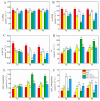The Protective Effect of Exogenous Ascorbic Acid on Photosystem Inhibition of Tomato Seedlings Induced by Salt Stress
- PMID: 36987066
- PMCID: PMC10052531
- DOI: 10.3390/plants12061379
The Protective Effect of Exogenous Ascorbic Acid on Photosystem Inhibition of Tomato Seedlings Induced by Salt Stress
Abstract
This study investigated the protective effects of exogenous ascorbic acid (AsA, 0.5 mmol·L-1) treatment on salt-induced photosystem inhibition in tomato seedlings under salt stress (NaCl, 100 mmol·L-1) conditions with and without the AsA inhibitor lycorine. Salt stress reduced the activities of photosystem II (PSII) and PSI. AsA treatment mitigated inhibition of the maximal photochemical efficiency of PSII (Fv/Fm), maximal P700 changes (Pm), the effective quantum yields of PSII and I [Y(II) and Y(I)], and non-photochemical quenching coefficient (NPQ) values under salt stress conditions both with and without lycorine. Moreover, AsA restored the balance of excitation energy between two photosystems (β/α-1) after disruption by salt stress, with or without lycorine. Treatment of the leaves of salt-stressed plants with AsA with or without lycorine increased the proportion of electron flux for photosynthetic carbon reduction [Je(PCR)] while decreasing the O2-dependent alternative electron flux [Ja(O2-dependent)]. AsA with or without lycorine further resulted in increases in the quantum yield of cyclic electron flow (CEF) around PSI [Y(CEF)] while increasing the expression of antioxidant and AsA-GSH cycle-related genes and elevating the ratio of reduced glutathione/oxidized glutathione (GSH/GSSG). Similarly, AsA treatment significantly decreased the levels of reactive oxygen species [superoxide anion (O2-) and hydrogen peroxide (H2O2)] in these plants. Together, these data indicate that AsA can alleviate salt-stress-induced inhibition of PSII and PSI in tomato seedlings by restoring the excitation energy balance between the photosystems, regulating the dissipation of excess light energy by CEF and NPQ, increasing photosynthetic electron flux, and enhancing the scavenging of reactive oxygen species, thereby enabling plants to better tolerate salt stress.
Keywords: ascorbic acid; photoprotection; photosystem inhibition; salt stress; tomato.
Conflict of interest statement
The authors declare that they have no conflict of interest.
Figures












Similar articles
-
Ascorbic Acid-Induced Photosynthetic Adaptability of Processing Tomatoes to Salt Stress Probed by Fast OJIP Fluorescence Rise.Front Plant Sci. 2021 Aug 16;12:594400. doi: 10.3389/fpls.2021.594400. eCollection 2021. Front Plant Sci. 2021. PMID: 34484251 Free PMC article.
-
Improving Plant Growth and Alleviating Photosynthetic Inhibition and Oxidative Stress From Low-Light Stress With Exogenous GR24 in Tomato (Solanum lycopersicum L.) Seedlings.Front Plant Sci. 2019 Apr 16;10:490. doi: 10.3389/fpls.2019.00490. eCollection 2019. Front Plant Sci. 2019. PMID: 31057589 Free PMC article.
-
Exogenous putrescine alleviates photoinhibition caused by salt stress through cooperation with cyclic electron flow in cucumber.Photosynth Res. 2019 Sep;141(3):303-314. doi: 10.1007/s11120-019-00631-y. Epub 2019 Apr 19. Photosynth Res. 2019. PMID: 31004254
-
Photosystems under high light stress: throwing light on mechanism and adaptation.Photosynthetica. 2023 May 30;61(2):250-263. doi: 10.32615/ps.2023.021. eCollection 2023. Photosynthetica. 2023. PMID: 39650670 Free PMC article. Review.
-
Strategies for adaptation to high light in plants.aBIOTECH. 2024 May 13;5(3):381-393. doi: 10.1007/s42994-024-00164-6. eCollection 2024 Sep. aBIOTECH. 2024. PMID: 39279858 Free PMC article. Review.
Cited by
-
The Use of Compost and Arbuscular Mycorrhizal Fungi and Their Combination to Improve Tomato Tolerance to Salt Stress.Plants (Basel). 2024 Aug 11;13(16):2225. doi: 10.3390/plants13162225. Plants (Basel). 2024. PMID: 39204661 Free PMC article.
-
Exogenous ascorbic acid as a potent regulator of antioxidants, osmo-protectants, and lipid peroxidation in pea under salt stress.BMC Plant Biol. 2024 Apr 5;24(1):247. doi: 10.1186/s12870-024-04947-3. BMC Plant Biol. 2024. PMID: 38575856 Free PMC article.
-
Melatonin Alleviates Photosynthetic Injury in Tomato Seedlings Subjected to Salt Stress via OJIP Chlorophyll Fluorescence Kinetics.Plants (Basel). 2025 Mar 6;14(5):824. doi: 10.3390/plants14050824. Plants (Basel). 2025. PMID: 40094835 Free PMC article.
-
Melatonin Improves Salt Tolerance in Tomato Seedlings by Enhancing Photosystem II Functionality and Calvin Cycle Activity.Plants (Basel). 2025 Jun 11;14(12):1785. doi: 10.3390/plants14121785. Plants (Basel). 2025. PMID: 40573778 Free PMC article.
References
-
- Hossain M.S., Alam M.U., Rahman A., Hasanuzzaman M., Nahar K., Mahmud J.A., Fujita M. Use of iso-osmotic solution to understand salt stress responses in lentil (Lens culinaris Medik.) S. Afr. J. Bot. 2017;113:346–354. doi: 10.1016/j.sajb.2017.09.007. - DOI
-
- Mushtaq Z., Faizan S., Gulzar B. Salt stress, its impacts on plants and the strategies plants are employing against it: A review. J. Appl. Biol. Biotechnol. 2020;8:81–91. doi: 10.7324/JABB.2020.80315. - DOI
Grants and funding
LinkOut - more resources
Full Text Sources

